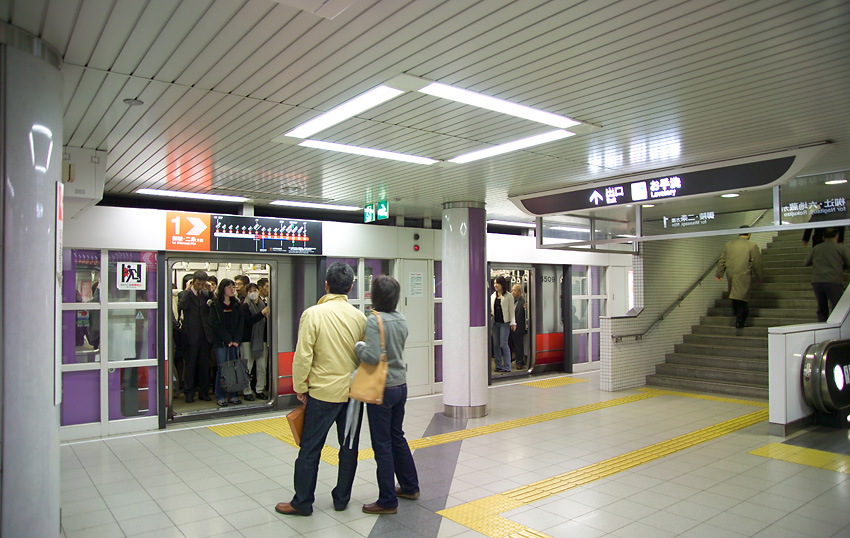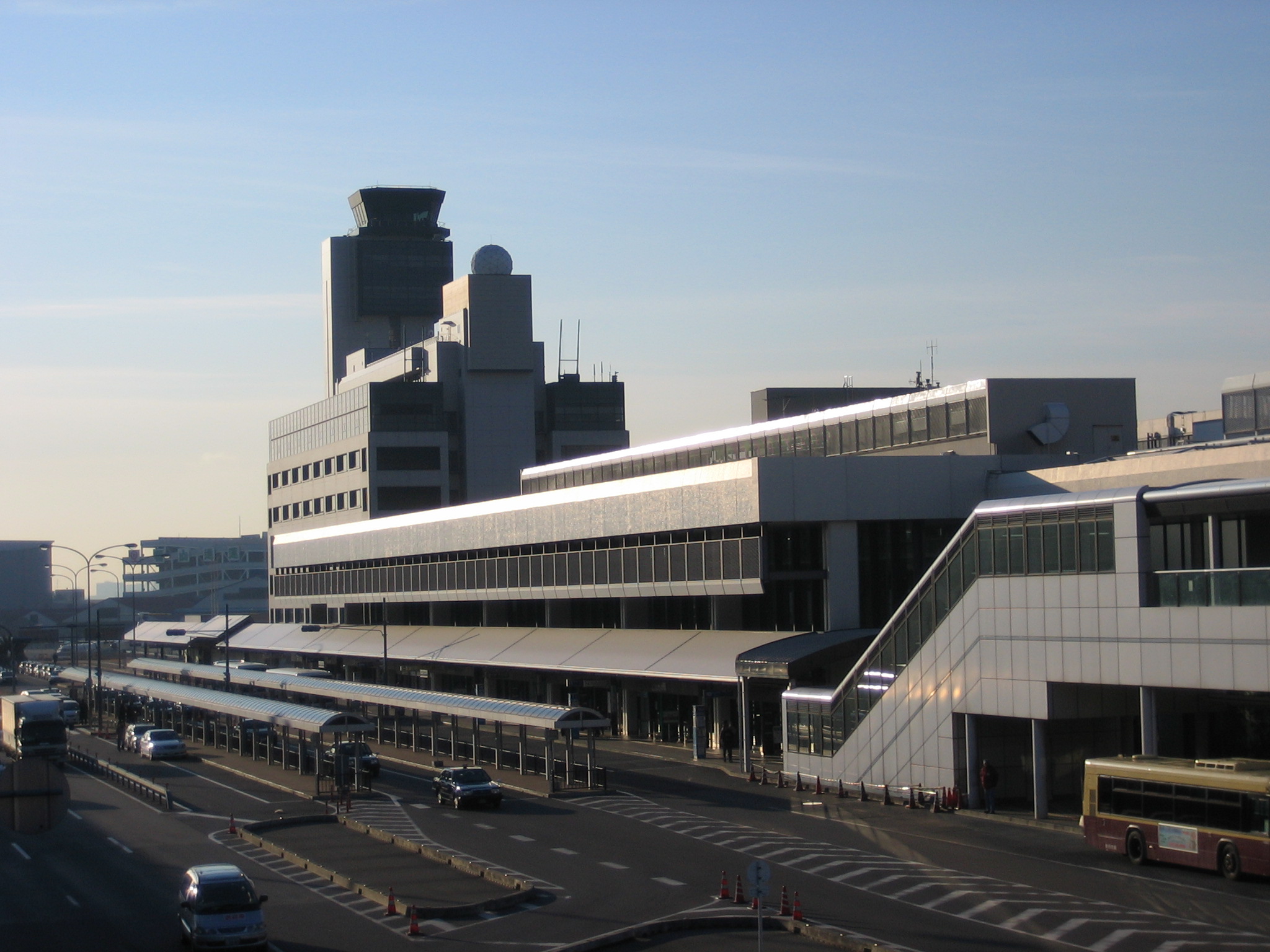|
Kyoto Municipal Subway 50 Series
The is an electric multiple unit (EMU) commuter train type operated by the Kyoto Municipal Subway in Kyoto, Japan, since 1997. Overview The 50 series was introduced in 1997 with 14 6-car sets built by the end of 1997 to coincide with the opening of the Tōzai Line. The remaining 18 cars (3 sets) would be built in 2004 for the opening of an extension from Rokujizō Station to Daigo Station. The trains are smaller than most other trains in the country because of the smaller tunnels carved out during construction. Interior Passenger accommodation consists of longitudinal bench seating throughout. Priority seating and wheelchair space is provided on all vehicles. Formations The six-car trains are formed as follows, with four motored ("M") cars and two non-powered trailer cab ("Tc") cars. * The "M1" and "M1'" cars are equipped with two pantographs. Gallery File:Inside Tozai line 20140720.JPG, Interior of the subway car File:Kyoto 50 wheelchair space.JPG, View of t ... [...More Info...] [...Related Items...] OR: [Wikipedia] [Google] [Baidu] |
Kinki Sharyo
is a Japanese manufacturer of railroad vehicles based in Osaka. It is an affiliate company of Kintetsu Corporation. In business since 1920 (as Tanaka Rolling Stock Works) and renamed The Kinki Sharyo Co., Ltd in 1945. They have produced light rail vehicles used by a number of transportation agencies, especially in the United States. Kinki Sharyo is listed on the Tokyo Stock Exchange as Clients North America * Boston's MBTA Green Line * LA's Metro A, E, L, and C lines. * New Jersey's Hudson-Bergen and Newark Light Rail systems * San Jose's VTA Light Rail * Phoenix's Valley Metro Rail * Seattle's Sound Transit Central Link Light Rail * Dallas Area Rapid Transit (DART) light rail Dallas, Texas ( Kinki Sharyo SLRV) Japan * JR Group * Kintetsu * Hanshin Electric Railway * Nankai Electric Railway * Osaka Municipal Transportation Bureau * Sendai City Transportation Bureau Asia * Dubai, UAE's Dubai Metro * Hong Kong's Kowloon–Canton Railway (merged with Mass Trans ... [...More Info...] [...Related Items...] OR: [Wikipedia] [Google] [Baidu] |
Kyoto Municipal Subway
The , also known as Kyoto City Subway, is the rapid transit network in the city of Kyoto, Japan. Operated by the Kyoto Municipal Transportation Bureau, it has two lines. Lines The Kyoto Municipal Subway is made up of two lines: the long, 15-station Karasuma Line, and the long, 17-station Tōzai Line, which together share one interchange station (Karasuma Oike Station): Rolling stock Karasuma Line * Kyoto Municipal Subway 10 series * Kyoto Municipal Subway 20 series * Kintetsu 3200 series * Kintetsu 3220 series File:Kyoto City 10 series EMU early type 001.JPG, Kyoto Municipal Subway 10 series File:京都市営地下鉄20系KS31編成 急行 国際会館行.jpg, Kyoto Municipal Subway 20 series File:Kintetsu-3200 001 JPN.JPG, Kintetsu 3200 series File:Kintetsu-3220 001 JPN.JPG, Kintetsu 3220 series Tozai Line * Kyoto Municipal Subway 50 series * Keihan 800 series File:Kyotoshi5604keihan814.jpg, Kyoto Municipal Subway 50 series and Keihan 800 series Network Ma ... [...More Info...] [...Related Items...] OR: [Wikipedia] [Google] [Baidu] |
Tōzai Line (Kyoto)
The is a Kyoto Municipal Subway line which runs from the southeastern area of the city (starting from Rokujizo Station), then east to west (i.e. ''tōzai'' in Japanese) through the Kyoto downtown area. The Kyoto Municipal Transportation Bureau operates the system along with the Karasuma Line and the City Bus. The present terminal stations are Rokujizo Station in Uji and Uzumasa Tenjingawa Station in Ukyō-ku, Kyoto. It handles an average of 241,133 passengers daily (2009 data). The stations are wheelchair-friendly, with elevators, narrow gaps between platform and train, and no height differences at places like restrooms. Each station has a colour code for easy recognition. All platforms on the line are island platforms, and have platform screen doors separating the platform from the tracks. The line is 17.5 km long with a track gauge of . The entire length is double-track. Trains are electric, operating on 1,500 V DC. Trains travel between Rokujizō and Uzumasa Tenjingaw ... [...More Info...] [...Related Items...] OR: [Wikipedia] [Google] [Baidu] |
Variable-frequency Drive
A variable-frequency drive (VFD) is a type of motor drive used in electro-mechanical drive systems to control AC motor speed and torque by varying motor input frequency and, depending on topology, to control associated voltage or current variation., quote is per definition on p. 4 of NEMA Standards Publication ICS 7.2-2021. VFDs may also be known as 'AFDs' (adjustable-frequency drives), 'ASDs' (adjustable-speed drives), 'VSDs' (variable-speed drives), 'AC drives', 'micro drives', 'inverter drives' or, simply, 'drives'. VFDs are used in applications ranging from small appliances to large compressors. An increasing number of end users are showing greater interest in electric drive systems due to more stringent emission standards and demand for increased reliability and better availability. Systems using VFDs can be more efficient than those using throttling control of fluid flow, such as in systems with pumps and damper control for fans. However, the global market penetration fo ... [...More Info...] [...Related Items...] OR: [Wikipedia] [Google] [Baidu] |
Pantograph (transport)
A pantograph (or "pan" or "panto") is an apparatus mounted on the roof of an electric train, tram or electric bus to collect power through contact with an overhead line. By contrast, battery electric buses and trains are charged at charging stations. The pantograph is a common type of current collector; typically, a single or double wire is used, with the return current running through the rails. The term stems from the resemblance of some styles to the mechanical pantographs used for copying handwriting and drawings. Invention The pantograph, with a low-friction, replaceable graphite contact strip or "shoe" to minimise lateral stress on the contact wire, first appeared in the late 19th century. Early versions include the bow collector, invented in 1889 by Walter Reichel, chief engineer at Siemens & Halske in Germany, and a flat slide-pantograph first used in 1895 by the Baltimore and Ohio Railroad The familiar diamond-shaped roller pantograph was devised and patented b ... [...More Info...] [...Related Items...] OR: [Wikipedia] [Google] [Baidu] |
Electric Multiple Unit
An electric multiple unit or EMU is a multiple-unit train consisting of self-propelled carriages using electricity as the motive power. An EMU requires no separate locomotive, as electric traction motors are incorporated within one or a number of the carriages. An EMU is usually formed of two or more semi-permanently coupled carriages, but electrically powered single-unit railcars are also generally classed as EMUs. The great majority of EMUs are passenger trains, but versions also exist for carrying mail. EMUs are popular on commuter and suburban rail networks around the world due to their fast acceleration and pollution-free operation. Being quieter than diesel multiple units (DMUs) and locomotive-hauled trains, EMUs can operate later at night and more frequently without disturbing nearby residents. In addition, tunnel design for EMU trains is simpler as no provision is needed for exhausting fumes, although retrofitting existing limited-clearance tunnels to accommodate the ... [...More Info...] [...Related Items...] OR: [Wikipedia] [Google] [Baidu] |
Rokujizō Station
Rokujizō Station (六地蔵駅 ''Rokujizō-eki'') refers to three different railway stations of the same name, located within the same vicinity in Rokujizo Naramachi, Uji, Kyoto, each operated by a different train company. Only the station of the Keihan Uji Line is located in Momoyamacho Inaba, Fushimi-ku, Kyoto. The station name means "Six Jizō". Keihan Electric railway station number is KH73, JR West Station number is JR-D06, and the Kyoto Municipal subway station number is T01. Lines Each of the following three lines has its own Rokujizō Station facilities. * Keihan Uji Line * Nara Line * ** Firstly, there is the relatively recent addition of a station at the terminus of the Subway Tozai Line that runs from Uzumasa Tenjingawa Station in Kyoto down to the southeastern part of the city. Secondly, in proximity to the municipal subway station is the station operated by West Japan Railway Company, on the Nara Line. Rapid trains from Kyoto now also stop here (in addition ... [...More Info...] [...Related Items...] OR: [Wikipedia] [Google] [Baidu] |
Daigo Station (Kyoto)
is a train station on the Kyoto Municipal Subway Tōzai Line in Fushimi-ku, Kyoto, Japan. Lines * ** (Station Number: T03) Layout The subway station has an island platform serving two tracks separated by platform screen doors Platform screen doors (PSDs), also known as platform edge doors (PEDs), are used at some train, rapid transit and people mover stations to separate the platform from train tracks, as well as on some bus rapid transit, tram and light rail syste .... File:Kyoto-subway-T03-Daigo-station-platform-20111214-131202.jpg, Platform References Railway stations in Kyoto Prefecture Railway stations in Japan opened in 1997 {{Kyoto-railstation-stub ... [...More Info...] [...Related Items...] OR: [Wikipedia] [Google] [Baidu] |
Electric Multiple Units Of Japan
Electricity is the set of physical phenomena associated with the presence and motion of matter that has a property of electric charge. Electricity is related to magnetism, both being part of the phenomenon of electromagnetism, as described by Maxwell's equations. Various common phenomena are related to electricity, including lightning, static electricity, electric heating, electric discharges and many others. The presence of an electric charge, which can be either positive or negative, produces an electric field. The movement of electric charges is an electric current and produces a magnetic field. When a charge is placed in a location with a non-zero electric field, a force will act on it. The magnitude of this force is given by Coulomb's law. If the charge moves, the electric field would be doing work on the electric charge. Thus we can speak of electric potential at a certain point in space, which is equal to the work done by an external agent in carrying a unit of p ... [...More Info...] [...Related Items...] OR: [Wikipedia] [Google] [Baidu] |
Transport In Kyoto
Transport in the Keihanshin metropolitan region is much like that of Tokyo: it includes public and private rail and highway networks; airports for international, domestic, and general aviation; buses; motorcycle delivery services, walking, bicycling, and commercial shipping. The nexus is in the central part of Osaka, though Kobe and Kyoto are major centers in their own right. Every part of Keihanshin has rail or road transport services. The sea and air transport is available from a limited number of ports for the general public. Public transport within Keihanshin is dominated by an extensive public system, beginning with an urban rail network second only to that of Greater Tokyo, consisting of over seventy railway lines of surface trains and subways run by numerous operators; buses, monorails, and trams support the primary rail network. Over 13 million people use the public transit system daily as their primary means of travel. Like Tokyo, walking and bicycling are much more common ... [...More Info...] [...Related Items...] OR: [Wikipedia] [Google] [Baidu] |
Kinki Sharyo Multiple Units
The or the , lies in the southern-central region of Japan's main island Honshū. The region includes the prefectures of Nara, Wakayama, Kyoto, Osaka, Hyōgo and Shiga, often also Mie, sometimes Fukui, Tokushima and Tottori. The metropolitan region of Osaka, Kobe and Kyoto (Keihanshin region) is the second-most populated in Japan after the Greater Tokyo Area. Name The terms , , and have their roots during the Asuka period. When the old provinces of Japan were established, several provinces in the area around the then-capital Kyoto were collectively named Kinai and Kinki, both roughly meaning "the neighbourhood of the capital". Kansai (literally ''west of the tollgate'') in its original usage refers to the land west of the Osaka Tollgate (), the border between Yamashiro Province and Ōmi Province (present-day Kyoto and Shiga prefectures).Entry for . Kōjien, fifth edition, 1998, During the Kamakura period, this border was redefined to include Ōmi and Iga Provinces. It i ... [...More Info...] [...Related Items...] OR: [Wikipedia] [Google] [Baidu] |







